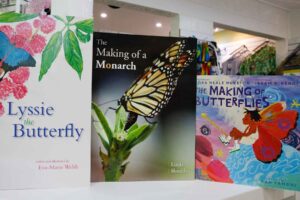When butterflies and moths flourish, so do most birds, bats and freshwater fishes. As pollinators (day and night!), they help plant life as well. They recycle waste material too, by eating rotten flesh and vegetation.
Did you know that some species – for example, the Ulysses butterfly – have been in decline over the last decade or so? The more humans do for them, hopefully the more survive.
Fancy trying to help? Here are some things you might be interested in!
1. Make your lawn into a diverse habitat
Traditional lawns are deserts for biodiversity; they don’t support many animals. Butterflies and moths don’t need much space to survive, so changing just 10% of a lawn back to natural vegetation can help. You’ll also save on water, insecticide, fertiliser, and herbicide.

2. Grow host plants
These are also called food plants. If you have a look at our website, you’ll be able to see which plants to grow to attract specific species.

3. Use less pesticide and herbicide
Many are used in lawns, gardens, and parks to make the spaces look better. The big downside here is that they can also harm beneficial insects.

4. Use less lighting outdoors
Moths are attracted to lights at night. We think that’s because they navigate by moonlight. Constantly flying around and around can result in death by exhaustion and attract predators too. You could try motion-activated lighting, or just turn it off when you don’t need it. You’ll save on energy use as well.

5. Use less soap when you wash your car.
It can contain quite a variety of pollutants: ammonia, heavy metals, nitrogen, and phosphorous, among others. Use reclaimed water if you can, and biodegradable soap.
6. Tell people about the benefits of having them around.
Both butterflies and moths are important pollinators. They are an important source of food for their predators, they help some matter decompose, help in science and technology (for example, the scales that make up their wings helped in the design of solar panels), and they provide pleasure to look at!

7. Advocate for them!
It’s a powerful way to increase awareness and appreciation of lepidoptera (the scientific name for butterflies and moths). The first animal a child meets is likely to be an insect, and the more positive experiences a child can have with them, the more likely they are to grow up with an appreciation of nature. A lot of primary schools do a butterfly breeding program.






